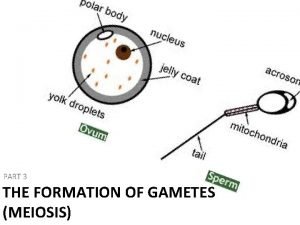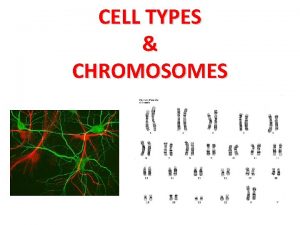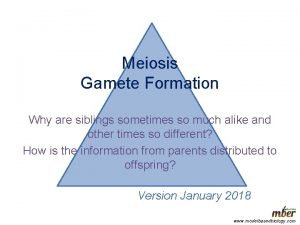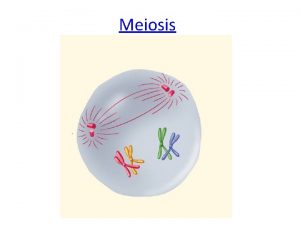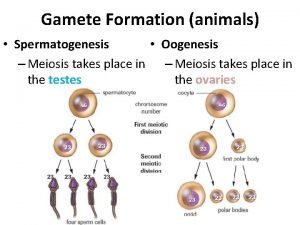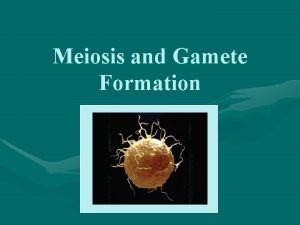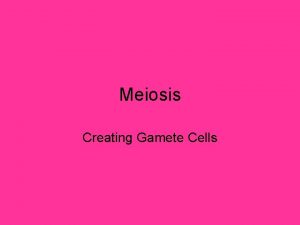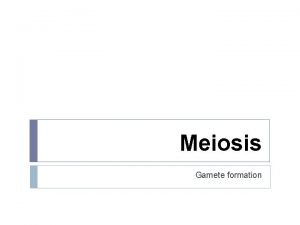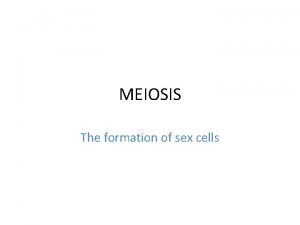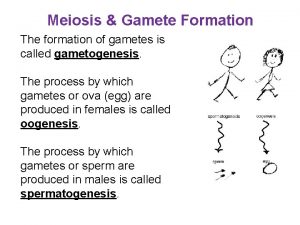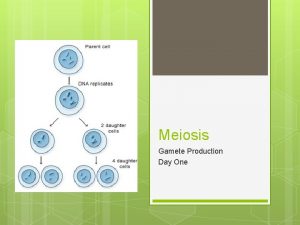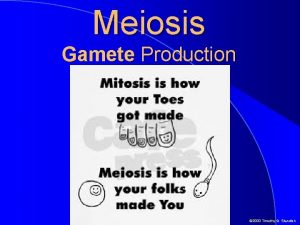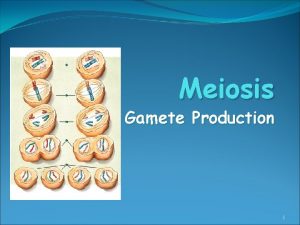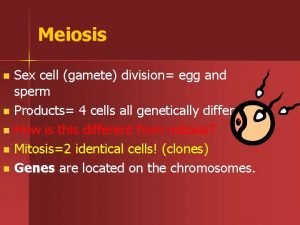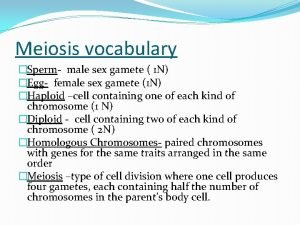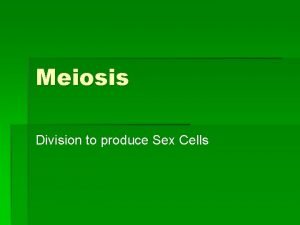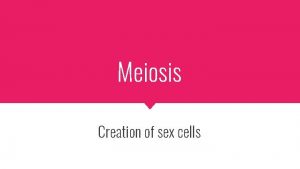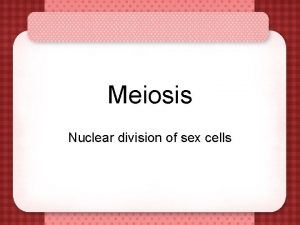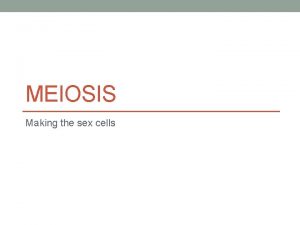MEIOSIS The formation of Sex Cells 1 Gamete




















- Slides: 20

MEIOSIS The formation of Sex Cells! 1

Gamete: A sex cell with half the # of chromosomes as a somatic cell. Sex Chromosomes: In humans, the 23 rd pair of chromosomes. This determines the biological gender of the individual. Biological females have two “X” chromosomes: XX Biological males have one “X” and one “Y”: XY Autosomes: All other chromosomes. Haploid (n): A cell with ONE set of chromosomes. For humans, the haploid number is n = 23. Diploid (2 n): Having TWO sets of chromosomes. For humans, the diploid number is n = 46. Gametes are Haploids. Somatic cells are Diploids. 2

Gametes Somatic Cell Sex Chromosomes Autosomes Haploid Diploid 3

Fertilization: the fusion of male and female gametes (n + n = 2 n) Zygote: the 2 n cell resulting from fertilization. Homologous Chromosomes: A pair of chromosomes that share similar characteristics. For instance, Chromosome 1 from the female and Chromosome 1 from the male create a pair of homologous chromosomes. Both will code for the same set of characteristics (Eg. Eye colour), but each may have different versions of the characteristic (Eg. Brown vs. Blue). 4

WHAT IS MEIOSIS? ! The special form of cell division that produces GAMETES � Remember these have HALF the number of CHROMOSOMES as somatic cells. � MEIOSIS: DIPLOID (2 n) HAPLOID (n) FERTILIZATION: HAPLOID (n) DIPLOID (2 n) 5


IN HUMANS, MEIOSIS OCCURS IN THE GONADS Ovary Testicle The formation of gametes: � Male: “SPERMATOGENESIS” - sperm � Female: OOGENESIS - egg or ova Whether in a male or female, the process of MEIOSIS is the same. 7

Starts with a “Germ Cell: ” A diploid(2 n) cell that will become a sex cell (n). Involves TWO cell divisions: Meiosis II Results in the production of four haploid daughter cells 8

INTERPHASE The germ cell starts off as a diploid, 2 n. � Each CHROMOSOME replicates, resulting in 4 n. 2 n 4 n 9

MEIOSIS I PROPHASE I The chromosomes condense. Sister chromatids are held together by a centromere. CROSSING OVER: Segments of chromosomes are exchanged between a pair of homologous chromosomes. Tetrad: the entity made when homologous chromosomes cross. - Nuclear membrane begins breaking down - Centrioles start forming spindle fibres.

MEIOSIS I METAPHASE I Homologous chromosomes line up in pairs in the middle of the cell. Spindle fibers attach to centromeres.

MEIOSIS I ANAPHASE I Homologous chromosomes are pulled to opposite sides of the cell.

MEIOSIS I TELOPHASE I Spindle fibres break down New nuclear membranes form. If in a human, each nuclei has 23 chromosomes – same as parental cell. Cytokinesis occurs, but the 2 daughter cells remain adjacent to each other. In Animal Cells: Cell membrane is pinched. In Plant Cells: A Cell Plate forms between the cells.

MEIOSIS II PROPHASE II Spindle fibers attach to chromosomes.

MEIOSIS II METAPHASE II Chromosomes line up randomly in the middle of the cell

MEIOSIS II ANAPHASE II Centromeres split Sister chromatids separate and move to opposite sides of each cell.

MEIOSIS II TELOPHASE II Four nuclei form around the chromosomes. Spindle fibres break down. Cytokinesis occurs.

MEIOSIS & GENETIC VARIATION Mitosis Asexual reproduction Daughter cells are genetically identical Meiosis Sexual reproduction Gametes are genetically different – contributes to diversity How does meiosis achieve this? 1. Crossing Over in Prophase I: causes different combinations of genes on chromosomes. 2. Random Order in Metaphase I: chromosomes line up randomly, so it’s random which daughter cell each chromosome ends up in.

MITOSIS VS. MEIOSIS • Both are involved in cell division • DNA is copied before both mitosis and meiosis # Divisions Pairing of Chromosomes Does it create haploid of diploid cells? # Daughter cells/parent Genetic Variation Parental Cell / Location Function in Plants & Animals MITOSIS MEOISIS 1 2 Pairing of homologous chromosomes does not occur. Pairing of homologous chromosomes occurs during Prophase I. Diploid Haploid 2 4 Daughter cells are genetically identical Daughter cells are not genetically identical. Somatic Cells in the Body Germ Cells in the Gonads Growth & Repair Sexual Reproduction – providing genetic variation

MITOSIS VS. MEIOSIS
 Sex snv
Sex snv Sex sex sex
Sex sex sex Sex sex sex
Sex sex sex Sex sex sex
Sex sex sex Sex sex sex
Sex sex sex Mitosis and meiosis
Mitosis and meiosis What is the difference between somatic and gamete cells
What is the difference between somatic and gamete cells Gamete production
Gamete production Modelbasedbiology
Modelbasedbiology Gamete formation
Gamete formation Oogenesis
Oogenesis Sex determination and sex linkage
Sex determination and sex linkage Sex determination and sex linkage
Sex determination and sex linkage Once a sex offender always a sex offender
Once a sex offender always a sex offender Y chromosome traits
Y chromosome traits Chapter 10 section 1: meiosis
Chapter 10 section 1: meiosis Crossing over occurs during:
Crossing over occurs during: Meiosis 1
Meiosis 1 Differences between mitosis and meiosis
Differences between mitosis and meiosis Anaphase meiosis vs mitosis
Anaphase meiosis vs mitosis Study guide chapter 10 section 1 meiosis
Study guide chapter 10 section 1 meiosis





